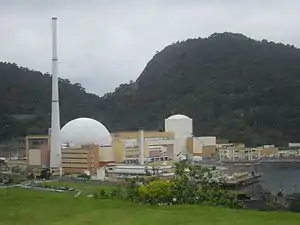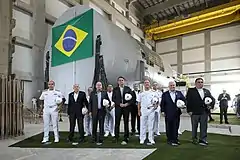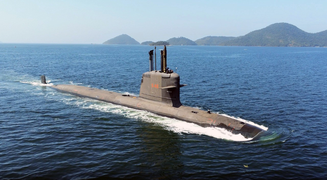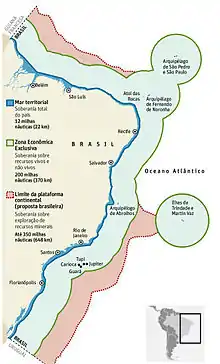Brazilian submarine Álvaro Alberto
The Brazilian submarine Álvaro Alberto is a nuclear-powered attack submarine (SSN) under construction for the Brazilian Navy, by the Itaguaí Construções Navais (ICN). The construction is part of the strategic partnership signed between France and Brazil in 2009, which also included the total transfer of technology and support for the construction of four enlarged conventionally-powered Scorpène-class submarines.[9]
 Álvaro Alberto SSN profile | |
| Class overview | |
|---|---|
| Name: | Álvaro Alberto |
| Builders: | ICN |
| Operators: |
|
| Cost: | US$ 7.4 billion (2020 est.)[1][2] |
| Built: | 2018–present |
| Planned: | 1 |
| Building: | 1 |
| General characteristics | |
| Type: | Nuclear attack submarine |
| Displacement: | 6,000 t[4] |
| Length: | 100 m (330 ft)[4] |
| Beam: | 9.8 m (32 ft)[4] |
| Propulsion: | Nuclear reactor RMB, 48 MW (64,000 hp)[5] |
| Speed: | Over 25 knots (46 km/h; 29 mph)[6] |
| Range: | Unlimited[7] |
| Endurance: | Unlimited in terms of propulsion, air and water, but otherwise typically 75 days, based on the amount of food carried and endurance of the crew[8] |
| Test depth: | Planned for 350 m (1,148 ft 4 in)[6] |
| Complement: | Capacity for 100[7] |
| Armament: |
|
The namesake of the submarine will be a tribute to the Brazilian Navy vice admiral and scientist Álvaro Alberto da Motta e Silva, who is primarily responsible for the implementation of the Brazilian Nuclear Program.[10] He was also Brazil's representative on the UN Atomic Energy Commission (UNAEC) and President of Brazilian Academy of Sciences for two terms, from 1935–1937 and 1949–1951.[11]
Brazil is the seventh country in the world, and the first in Latin America and the Southern Hemisphere, to acquire the technology for the construction of nuclear submarines.[12][8][13]
History
The navy's nuclear submarine project dates back to the 1970s, more practically between 1976 and 1978. It was decided by program officials at the time that the country should obtain the three-point processes before moving on to submarine construction. The first point was the nuclear fuel cycle domain, known internally as the Zarcão and Ciclone projects. Second develop a nuclear reactor for use in the submarines, the Remo project. As a third point, the country would need to acquire the knowledge to design and build a hull to accommodate the developing reactor, the Costado project.[7]
Fuel cycle domain

The beginning of the project for the domain of the fuel cycle and nuclear reactor took place in 1979, that year the Brazilian Navy joined the IPEN-SP (Institute of Energy and Nuclear Research of São Paulo) where it started to work in most ambitious program in the country to date. In 1982, the Navy won its first major victory after adopting the ultracentrifugation technique for enrichment and learning about uranium hexafluoride technology in the city of Poços de Caldas, Minas Gerais. In the same year, the project researchers achieved isotopic uranium enrichment with centrifuges built entirely in Brazil.[7]
To support the experimental activities of the research and development program of the fuel cycle and nuclear reactors, the Aramar Experimental Center (CEA) was built in the municipality of Iperó, São Paulo. The center is home to testing facilities, experimental validation laboratories and some special workshops. It is also responsible for uranium enrichment on a small industrial scale, but sufficient to power existing nuclear research reactors in the country. Over a period of approximately 20 years, the country acquired the nuclear fuel cycle and was able to begin the construction of the nuclear reactor.[7]
Nuclear reactor

In 2014, after many years of a series of problems, delays in federal funding and program freezes, the first nuclear test reactor was built on land at the Aramar Experimental Center (CEA), with the aim of enabling the technological, industrial and operational processes of nuclear installations applicable to ship propulsion.[15][16] In 2018, was launch the first prototype of nuclear reactor for the Brazilian nuclear submarine program, known as the Brazilian Multipurpose Reactor (RMB).[17]
Submarine hull

At the beginning of the project in 1979, the Navy did not know the processes for submarine hull construction. First it was necessary to acquire new and modern submarines that could be built in Brazil. The first submarines were the Type 209 class of German origin. In 1982, the country signed contracts for the construction of five new navy submarines, four of them on Brazilian soil, at the Rio de Janeiro Navy Arsenal (AMRJ). The Navy also invested in the modernization of its facilities and in the training of the national industry, as well human qualification.
In 2009, Brazil purchased four enlarged Scorpène-class conventionally-powered submarines for US$9.9 billion with a total technology transfer agreement, giving to the country the knowledge for the design and construction of submarine hulls.[18] The first Brazilian Scorpène-class submarine, Riachuelo, was launched on 14 December 2018.[19]
The project was initiated in 2012 through the Submarine Development Program (PROSUB), with the Itaguaí base in Rio de Janeiro as the submarine development and manufacturing point. From 2010 to 2012, a group of 31 engineers, 25 officers and 6 civil employees, received theoretical training by the DCNS (now Naval Group) in France. In 2018, more than 400 Brazilian engineers worked on the nuclear submarine project staff, originally formed by the group that received training in France.[20]
Main reasons

The Brazilian Navy modernization program plans the development and construction of six nuclear attack submarines, as part of the national defense strategy that says that any effort to build or acquire nuclear submarines will be to develop strategic deterrence capability against "any hostile force" to the national land or sea territory.[21][22]
Brazil says that its future nuclear powered submarines capacity will serve as a "peaceful deterrent" and not "a weapon of war". The country adopts the policy of "no first use", also understands that with its future fleet, at least some of its weapons will be able to survive the first strike (nuclear or non-nuclear) of an enemy and prevent further attempts at aggression.[23]
Another main reason is the defense of the so-called Blue Amazon (Portuguese: A Amazônia Azul), a resource-rich area covering about 4,500,000 km2 (1,700,000 sq mi) off the Brazilian coast. This area is the country's exclusive economic zone, home to a huge diversity of marine species, valuable metallic minerals and other mineral resources, petroleum, and the world's second largest rare-earth reserve.[24][8][25]
Characteristics
Álvaro Alberto has many similarities to his conventional successor of the Scorpène class. The first Brazilian nuclear submarine will have a beam of 9.8 m (32 ft) to accommodate the pressurized water nuclear reactor (PWR). Its 100 m (330 ft) length and 6,000-ton displacement will be propelled by a 48 MW (64,000 hp) turbo-charged propulsion system.[26] The submarine will be able to carry torpedoes, anti-ship and cruise missiles, and naval mines in six torpedo tubes.[27][4]
Construction programme
| Name | Pennant No. | Builder | Laid down | Launched | Commissioned | Cost | Status |
|---|---|---|---|---|---|---|---|
| Álvaro Alberto | SN10 | ICN, Itaguaí, Rio de Janeiro | 2018 | 2030 (planned)[2] | 2032 (planned)[2] | US$7.4 billion (2020 est.)[1][2] | Under construction |
See also
- Barracuda-class a French class of comparable nuclear submarines
- Astute-class a British class of comparable nuclear submarines
- Attack submarine
- Cruise missile submarine
References
- "Atrasado pela crise, projeto do submarino nuclear já recebeu R$ 21 bilhões" (in Portuguese). Gazeta do Povo. 8 February 2018.
- "Programas da MB em 2019: PROSUB". Poder Naval (in Portuguese). 12 January 2020.
- "PROSUB: NUCLEP e ICN avançam na construção do Submarino Nuclear Brasileiro" (in Portuguese). Poder Naval. 2 August 2019.
- "Submarino Nuclear Brasileiro Alvaro Alberto (SN 10)" (in Portuguese). Defesa Aérea & Naval. 7 December 2012.
- "Submarino Nuclear Brasileiro" (in Portuguese). Retrieved 4 August 2019.
- "Programa Nuclear da Marinha" (in Portuguese). Retrieved 3 August 2019.
- "Brasil lanzó al mar un ultramoderno submarino para vigilar sus aguas" (in Spanish). La Nacion. 14 December 2019.
- "Base de submarino nuclear começará a ser construída em fevereiro" (in Portuguese). Terra. 30 January 2010.
- "Um cientista, uma história, Almirante Álvaro Alberto da Motta e Silva". Defesa Aérea & Naval (in Portuguese). 10 December 2015.
- "Álvaro Alberto da Mota e Silva". Academia Brasileira de Ciências (in Portuguese). Retrieved 5 August 2019.
- "Brazil launches first of five navy attack submarines". EFE. 14 December 2019.
- "Brazil take first step in program to join nuclear-powered sub club". Reuters. 14 December 2018.
- "Primeiro submarino nuclear brasileiro será usado em 2023". Revista Galileu (in Portuguese). Retrieved 5 August 2019.
- "Quem somos". CTMSP (in Portuguese). Retrieved 5 August 2019.
- "LABGENE: Conhecendo a planta nuclear do Submarino de propulsão Nuclear brasileiro". Defesa Aérea & Naval (in Portuguese). 30 August 2018.
- "Novos submarinos da MB: Senado aprova o empréstimo de 4,32 bilhões de euros" (in Portuguese). 2 September 2009.
- "Com Temer e Bolsonaro, Marinha lança submarino Riachuelo" (in Portuguese). Veja. 14 December 2019.
- "O Prosub" (in Portuguese). Retrieved 3 August 2019.
- "Estratégia Nacional de Defesa". Ministério da Defesa do Brasil (in Portuguese). Retrieved 7 September 2019.
- "Brazilian Navy - Marinha do Brasil - Modernization". GlobalSecurity.org. Retrieved 7 May 2019.
- "Brazilian Navy - Marinha do Brasil - Modernization". GlobalSecurity.org. Retrieved 5 March 2020.
- "Brazilian nuclear policy under Bolsonaro: no nuclear weapons, but a nuclear submarine". The Bulletin. 12 April 2019.
- "Brasil tem segunda maior reserva mundial de terras raras, mas não aparece entre os maiores produtores" (in Portuguese). O Globo. 30 May 2019.
- "Submarino Nuclear Brasileiro 'Alvaro Alberto' (SN 10)" (in Portuguese). Defesa Aérea & Naval. 7 December 2012.
- "Programa Nuclear da Marinha" (in Portuguese). Brazilian Navy. Retrieved 9 December 2018.